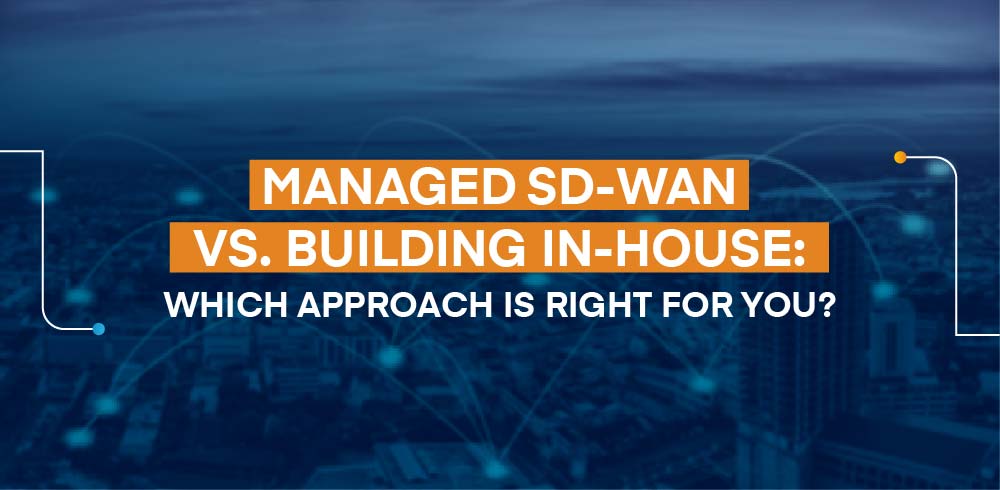
Here’s a quick guide for you to decide which SD-WAN deployment option you should choose to improve your network’s quality and meet the evolving requirements of the business.
The Software-Defined Wide Area Network (SD-WAN) has grown from a buzzword to a mature technology that has been extensively tested and deployed by companies of all sizes.
As companies widely embrace public clouds to meet their diverse connectivity requirements and engage with their stakeholders. They require next-gen network technology to manage cloud-based architectures with automated controls effectively
This is particularly critical because older technologies are marred by their inability to maintain virtualisation-friendly activities’ continuity patterns. Conventional network architectures cannot address the complexities of many modern digital transformation initiatives.
Hence, many enterprise decision-makers are looking at moving to SD-WAN to improve their network quality and meet changing business demands.
Why are enterprises embracing SD-WAN?
SD-WAN enables organizations to make networks more agile, configure them to meet changing customer demands while securing critical applications. It gives organizations the elasticity to access multi-cloud services on their sites without making substantial hardware investments.
Deployment of SD-WAN enables organizations to achieve outstanding WAN and application performance. It facilitates a granular security approach based on network type, time zone, and bandwidth traffic by educating networks on how particular traffic types should be managed and controlled.
There are two ways to deploy SD-WAN: organizations can either buy and install SD-WAN end-to-end by themselves or buy it as a managed service.
Given the intricate networks, cloud environments, and complicated processes, many businesses find it challenging to handle deployments such as SD-WAN on their own. On the other hand, the managed service model helps companies eliminate many subordinate tasks needed to support the service. Let’s look more closely at all the options you can consider.
Analyzing the best approach
It’s not easy to decide whether you build SD-WAN capabilities internally or go for managed SD-WAN. Technology leaders must carefully examine their networks and assess whether they can deploy the new technology internally or want a specialist to handle the solution.
In-house implementation, also known as Do-It-Yourself (DIY):
The performance of SD-WAN in-house comprises constructing and managing all components in-house. This can be a marathon exercise, especially if it involves tens or hundreds of office branches.
While some of the larger organizations may have adequate resources and technical expertise to deploy SD-WAN independently, many others, especially small and medium-sized enterprises, lack the appropriate IT know-how. Enterprises that pick this option should be aware that they will be responsible for managing the equipment, software, and human resources required for their own needs. In this case, the upfront capital investment would be made by the company. They should also be ready to invest in upgrading their IT teams’ skills and other investments to monitor networks and implement security tools.
This approach is preferable to companies with extensive knowledge, and technical capabilities to align their network architectures with the latest network surveillance and security tools. Organizations who want to ultimately retain control of their internal connectivity and security and have the knowledge, skills, and expertise to manage and support various troubleshooting may choose to do so
However, even if you believe that your organization has the necessary IT expertise, several other factors like security, the number of sites to connect, and the total cost of ownership must be evaluated by your IT teams before deciding which way to go. Organizations and technology leaders keen to build in-house SD-WAN may also need to re-assess or rescind their existing contracts for legacy networking technologies. All of this can result in additional costs and effort.
Fully managed:
The ongoing pandemic has already resulted in several challenges for the enterprises.
A fully managed SD-WAN service solution entrusts its entire operation, management, security, and troubleshooting responsibility to a trusted managed service provider. By adopting a managed solution strategy, organizations can get rid of multiple vendor agreements and reap rich dividends by trusting an experienced business adviser.
With a managed SD-WAN, organizations are better equipped to handle multiple remote locations and their network connectivity requirements, new cloud-based applications, track usage patterns and improve secure access to various applications. It helps businesses save time, bring down operating expenditures, and free-up IT resources to focus on other value-added tasks.
This approach works well for companies that lack the in-house talent to support SD-WAN deployment and management aspects. Additionally, those who want better profitability and need a trusted partner to provide exceptional connectivity support throughout their cloud network and deliver mission-critical SD-WAN deployments should consider the fully managed model.
The subscription-based model enables businesses to plan their long-term connectivity needs without putting a lot of stress internally. By supporting a professional partner and robust service level agreements, organizations can ensure consistent user experience within their network without worrying about investing in in-house talent and resources
Hybrid model
Another option that has been gaining increased traction for SD-WAN deployments is a hybrid model. This approach allows SD-WAN deployments to be co-managed between the client and the network service provider. Organizations that do not want to make an immediate transition to full SD-WAN or wish to retain a portion of their MPLS deployments may be more comfortable with this approach.
Many organizations that have put a significant amount of financial resources and effort into their legacy networks can discuss a detailed methodology on how best to adopt the SD-WAN using the hybrid approach. Some of the critical questions you must ponder before doing the SD-WAN deployment yourself or through a managed service provider are:
- Have you evaluated the contractual obligations of your existing WAN contract?
- Why do you want to deploy SD-WAN – for example, is it because of cost reduction, resilience, improved application performance, enhanced network visibility, or all that?
- Does your organization have the expertise to manage the implementations of SD-WAN itself?
- Do you want to make an upfront investment in any new technology implementation and incur additional costs to support the operations?
- Are you ready to incur the extra cost of allocating resources for in-house SD-WAN implementation, project planning and delivery?
SD-WAN’s most significant benefit is its ability to simplify the operation and management of a WAN. Irrespective of the approach you take, it is always recommended to turn to expert-managed service providers, like Nexapp, with the expertise and know-how to help you realize your business goals with SD-WAN transition.


